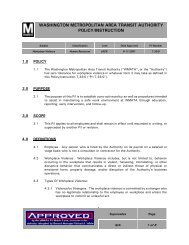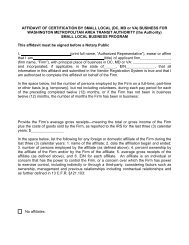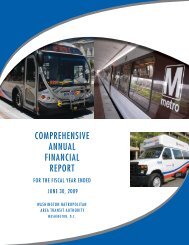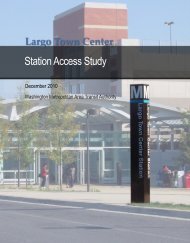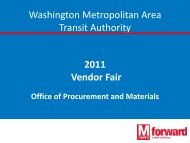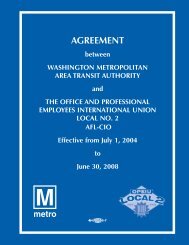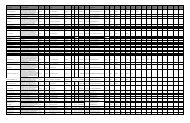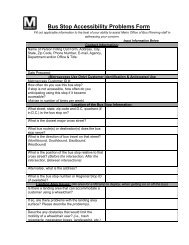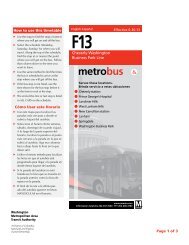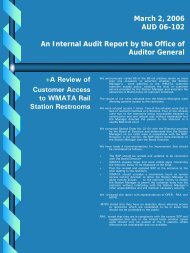07 CAFR cover FINAL.p65 - WMATA.com
07 CAFR cover FINAL.p65 - WMATA.com
07 CAFR cover FINAL.p65 - WMATA.com
- No tags were found...
You also want an ePaper? Increase the reach of your titles
YUMPU automatically turns print PDFs into web optimized ePapers that Google loves.
Washington Metropolitan Area Transit AuthorityFY 20<strong>07</strong> Comprehensive Annual Financial ReportNotes to Basic Financial StatementsJune 30, 20<strong>07</strong> and 2006(2) Plans of FinancingThe planning, development and operation of the transit facilities serving the Washington, D.C. metropolitan areaare funded from the <strong>com</strong>bined resources of the U.S. Government, the State of Maryland, the Commonwealth ofVirginia, the District of Columbia, the participating local jurisdictions, and the Authority's operations.The original federal funding for construction of the metrorail system was provided by authority of the NationalCapital Transportation Act of 1969 (Public Law 91-143). This Act was subsequently amended on January 3, 1980by Public Law 96-184, "The National Capital Transportation Amendment of 1979" (also known as the Stark-HarrisAct) which authorized additional funding and on November 15, 1990 by Public Law 101-551, "The NationalCapital Transportation Amendments of 1990" which authorized funding for <strong>com</strong>pletion of a 103-mile metrorailsystem. The Authority has also obtained funding under certain agreements to <strong>cover</strong> debt service on its transitbond obligations as more fully explained in note 6.The Authority's operations are funded primarily by farebox revenues from passengers and operating subsidypayments from participating jurisdictions. In establishing its budget each year, the Authority makes an estimate ofthe revenues it expects to receive from operation of the system based on the current or projected fare scheduleand ridership. The majority of the balance of the Authority's operating budget is provided through operatingsubsidy payments from the participating jurisdictions.Funding of these subsidy payments is authorized by the participating jurisdictions through their budgetingprocesses. Any subsequent operations funding requirements in excess of the initially budgeted estimates are duetwo years thereafter and are included in the ac<strong>com</strong>panying basic financial statements as contributions receivable.Any excess funding is credited to individual jurisdictional accounts for refund or for use as payment on current orfuture obligations as determined by the funding jurisdiction.The Authority’s Capital Improvement Program (CIP) consisting of the Infrastructure Renewal Program (IRP),System Access/Capacity Program (SAP) and System Expansion Program (SEP) is based on the results of anextensive needs assessment and the requirement to align resources to rehabilitate the existing systemsadequately and to grow ridership. The contributing jurisdictions have approved the Metro Matters program, whichfunds the IRP, the security program, and adds bus and rail capacity. The Authority’s capital budget is funded bygrants that use federal funds and substantial local contributions provided by participating jurisdictions, in excessof federal match requirements.(3) Cash, Deposits and InvestmentsAs provided in the amended Compact, any monies of the Authority may, at the discretion of the Board and subjectto any agreement or covenant between the Authority and the holders of its obligations limiting or restrictingclasses of investments, be invested in the following:1) Direct obligation of, or obligations guaranteed by, the United States;2) Bonds, debentures, notes, or other evidences of indebtedness issued by agencies of the United States;3) Domestic and Eurodollar certificates of deposit;30





